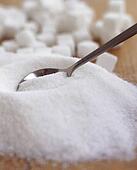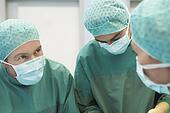Introduction: Type 2 diabetes mellitus (formerly non insulin dependent diabetes mellitus) appears to be prevalent at ‘epidemic’ levels in many places, including Iran, mainly due to changes in life style, but also because of better diagnosis and improved longevity.
Higher prevalence occurs in Asians, men, and the elderly (18% in men over 80 in Liverpool).
Most are over 40 years but teenagers are increasingly getting type 2 Diabetes Mellitus mainly as a matter of obesity due to physical inactivity, having unhealthy fast foods and soft drinks.
Diabetes mellitus type 2 has now become a global health problem and challenge. More than 340 million people, more than the U.S. total population, are known to suffer from the monstrous syndrome, according to the latest report announced by WHO.
Once it starts showing its symptoms, patients get so much anxious about the disease and its life threatening consequences.
- Cause:
Decreased insulin secretion and insulin resistance is associated with obesity, lack of exercise and calorie excess.
There is about 80% concordance in identical twins, indicating stronger genetic influence than in Type 1 Diabetes Mellitus.
Typically progresses from a preliminary phase of impaired glucose tolerance or impaired fasting glucose.
Maturity onset diabetes of the young (MODY) is a rare autosomal dominant form of Diabetes Mellitus affecting young people with a positive family history.
- How to start the curative plan
1. Case taking:
A thorough case taking is done by listening to the patient carefully and taking down the case in his own words. Then the prominent symptoms are derived and converted to rubrics in English language.
The main and more significant, mostly mental and general physical symptoms are then repertorized by homeopathic software, Radar being a well known diagnostic tool internationally.
2. Analysis is done before selecting proper remedy The next step is to analyze the rubrics presenting a certain number of remedies.
Homeopath puts an end to the process by selecting the most similar remedy to the patient’s character and personality traits.
3. Proper remedy is prescribed and taken by patient
We must not discharge the patients’ anti diabetic agents, primarily, if he is already taking them.
There are several methods to cure diabetic patients by homeopathic remedies as a complementary method; here I would like to present one of them which has shown to be more effective in calming anxious diabetic patients, normalize their lab values, cure and decrease expected complications;
a. Syzygium: One of the most useful remedies in curing diabetes mellitus. No other remedy leads to so marked degree of diminution and disappearance of sugar in the urine.
- The main symptoms are as follows:
Prickly heat in upper part of the body; small red pimples itch violently. Great thirst, weakness, emaciation, very large amount of urine, high specific gravity. Old skin ulcers , Diabetic foot ulceration.
- How to prescribe Syzygium?
It can be given in three different potencies; mother tincture, 2x and 3x. 3-5 drops of the remedy is taken by patient, preferably 20-30 minutes before meals,TDS(three times a day).
- How to prescribe the similar remedy?
The selected remedy after software analysis, is said to be taken as follows; depending on the patient sensitivity and vitality and age, 1-3 drops of the remedy with 30c potencyis said to be taken by him, TDS, 20-30 minutes after meals.
To increase the curative power and decrease the possibility of aggravation the remedy should be shaken vigorously 8, 10 or 12 times after taking the first dose.
- How to check FBS and Hgb A1c, and other lab values?
FBS or FPG is said to be controlled regularly along mostly with post prandial blood sugar after 2 hours.
Kidney function tests like urine analysis, creatinine , urea and uric acid, serum albumin are recommended to be done monthly. Hgb A1c is ordered to be checked seasonally.
- What about diet and exercise plan?
Diabetic patients are said to follow a regular diet and exercise plan. Choosing healthy foods including veggies, fruits, whole grain bread, low fat dairies and not taking artificial sugars, and sweeteners, are the main nutritional rules. Walking, jogging, swimming and doing other aerobic exercises 5 times a week for 30 minutes is recommended to be followed, as well.
It not only lowers blood sugar, but also keeps the patients’ happy, healthy, fitness , mental activity and lowers the chance of being affected by diabetes complications.
- Conclusion:
If diabetic patients follow the above mentioned diet and exercise plan, check the lab values regularly and use homeopathic remedies along with their anti diabetic agents under the control of their homeopath physicians, they will:
* Lower risk of diabetes complications
* Normalize their fasting blood sugar and Hgb A1c and other lab values
* Enhance their mental activity
* Enjoy a better life with higher quality
So let us think homeopathic to live a longer, healthier life.
By :Seyedaghanoor Sadeghi M.D. & homeopath
Source:Tehran Times









 The first set of well-being indicators has been created to enable the British government to evaluate the quality of life of Britishers.The research which took the opinion from online questionnaires found that happiness changed according to age. While children were happy with eat outs, games and friends, the youth lay more emphasis on stylish clothes, music, fast food and alcohol to give them a taste of happiness. The older lot gave more emphasis on health, finance, job stability and satisfaction to experience happiness.
The first set of well-being indicators has been created to enable the British government to evaluate the quality of life of Britishers.The research which took the opinion from online questionnaires found that happiness changed according to age. While children were happy with eat outs, games and friends, the youth lay more emphasis on stylish clothes, music, fast food and alcohol to give them a taste of happiness. The older lot gave more emphasis on health, finance, job stability and satisfaction to experience happiness. 

